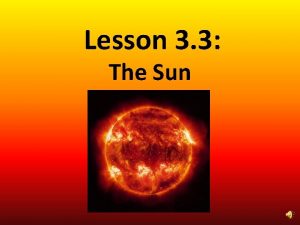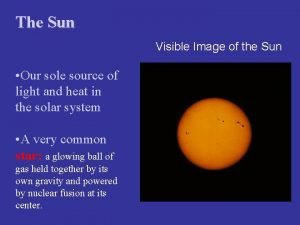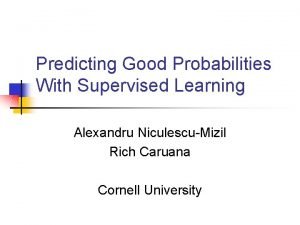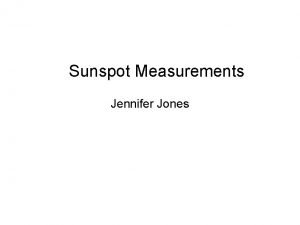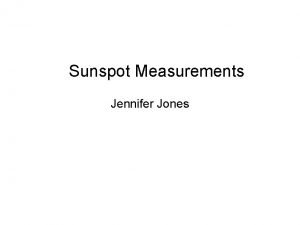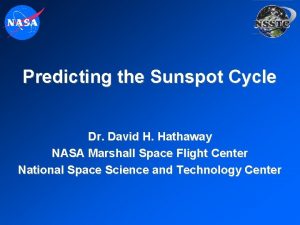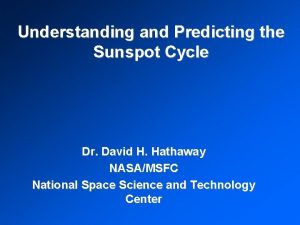Terminators Predicting the end of sunspot cycle 24











- Slides: 11

Terminators: Predicting the end of sunspot cycle 24 and its impacts on space weather, weather and climate AAS 234 – i. Poster 305. 03 Robert J. Leamon University of Maryland/ NASA GSFC leamonrj@umd. edu ; 202 -848 -3616 Scott W. Mc. Intosh NCAR High Altitude Observatory mscott@ucar. edu

Key Points • People have tried to tie El Niño to the solar cycle for years; we finally have because it's not solar max or min that's critical (don't smooth the data!). • Cycle 24 will Terminate and Cycle 25 will turn on mid-2020, and with it a change in cosmic ray flux and a swing from El Niño to La Niña. • Ergo we can predict it — the big “so what” is that governments can prepare for and mitigate “unpredictable natural disasters. ”

Terminators • Top: “F 10. 7” radio flux (activity proxy) • Middle: sunspot number (SSN) by hemisphere. • Bottom: coronal brightpoints (small scale magnetic features) • Sharp increase (<27 days) in SSN and F 10. 7 at Terminator; change in magnetic field configuration (complexity), change (sharp decrease) in galactic cosmic ray flux.

Technique • Key breakthrough: modified Superposed Epoch Analysis – Garmin/ Ironman training! • Solar cycles have different lengths (11 -ish) • Instead of superposition of time series data at 11 years, consider the “phase” or fraction of the cycle from terminator to terminator. • A coherent pattern emerges – note Oceanic Niño Index. ENSO F 10. 7 GCR h. SSN

Implications • Hurricanes: Atlantic sea surface temp and hurricane “power” peak first year in La Niña after El Niño (warm waters/ upper level wind shear). • Commodity Crops: Shocks in US Wheat, Corn and Oats prices show strong correlation with El Niño to La Niña swings at Terminators. • 2019 will be warmest year on record (cf. 1997 -98 El Niño — and Terminator); 2020 less hot. ENSO F 10. 7 GCR h. SSN

When will the Cycle Terminate? • Already have April 2020 from BP band tracking. • Hilbert Transform – signal processing technique (“phase of clock”) • “Wraps” of Hilbert phase also show that El Niño flips are not random but related…

Unit Cycle • Black line: average last 5 solar cycles from terminator to terminator (through June 2017). • Red hatch: error (standard deviation) • Black dot: “you are here” — May 2019 observation

Future Prediction • We already know when Cycle 24 will end (April 2020) • Enough of Cycle 25 visible to make (Oct 2031 ± 9 mo) • Take unit cycle prediction and stretch it between April 2020 and Oct 2031…

Climate and Climate Change… • Why does this relationship hold for the past six solar cycles? • A: Needs climate change. – Warming troposphere gives rise to a cooling stratosphere… – Couples with a thickened ionosphere during El Niño conditions (feedback loop from warm waters) – Making the atmosphere more susceptible to the rapid drop in incoming (charged) GCRs when the sun's magnetic field reconfigures at the Terminator… – Changing the atmospheric conductivity, reducing thunderstorm activity and shifting cloud patterns across the Pacific.

Jupiter… • “A Model of a Tidally Synchronized Solar Dynamo”, Stefani et al. • But need to rely on more than just planetary motions — they mention the Mc. Intosh & Leamon 55º and Rossby wave explanation: “It is here where also the specific role of the ± 55º latitude region for starting the dynamo cycle (Mc. Intosh, 2015) might find an explanation, which could not be provided by our simple 1 D model. ” • If only it was the 11 -ish year cycle we had to be concerned about, but it isn’t.

Summary • Band model/ Terminators can simultaneously explain: – solar cycle timing (minimum and maximum) – sudden onset in activity at Terminator – Rossby wave surges (don’t smooth the data) – hemispheric differences – why last solar cycle was unusually long – implications for El Niño and terrestrial weather/ climate.
 Sun means
Sun means Reddish loops of gas that link parts of sunspot regions
Reddish loops of gas that link parts of sunspot regions Sunspot solar oven
Sunspot solar oven Sunspots magnetic field
Sunspots magnetic field End to end accounting life cycle tasks
End to end accounting life cycle tasks Multiple procurement cycles
Multiple procurement cycles Predicting products of chemical reactions
Predicting products of chemical reactions Predicting products of chemical reactions
Predicting products of chemical reactions Synthesis reaction predicting products
Synthesis reaction predicting products Alexandru niculescu-mizil
Alexandru niculescu-mizil Activity series of metals
Activity series of metals Braden scale for predicting pressure sore risk
Braden scale for predicting pressure sore risk

